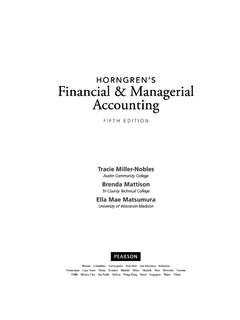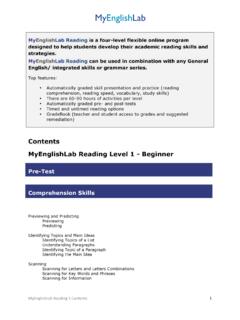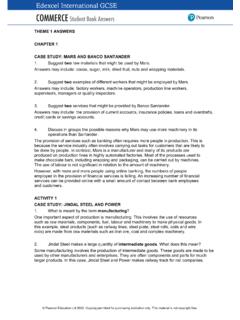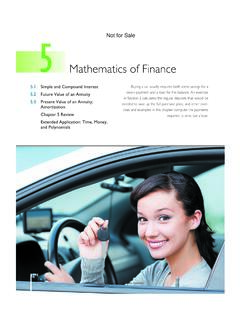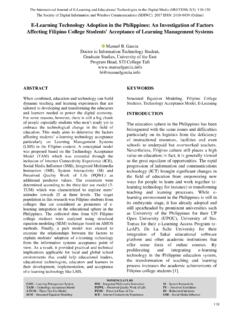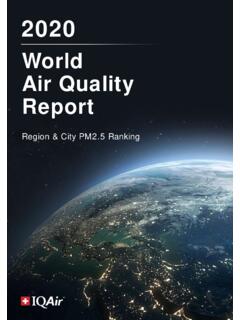Transcription of STUDENT BOOK ANSWERS UNIT 1 MARKETING AND PEOPLE …
1 Pearson Education Ltd 2018. Copying permitted for purchasing institution only. This material is not copyright free. 1 STUDENT BOOK ANSWERS UNIT 1 MARKETING AND PEOPLE Pearson Education Ltd 2018. Copying permitted for purchasing institution only. This material is not copyright free. 2 1 THE MARKET ACTIVITY 1 CASE STUDY: US DRYBAR 1. Using this case as an example, explain what is meant by a niche market. A niche market is a small market segment a segment that has sometimes gone untouched by larger businesses. Niche MARKETING is the complete opposite of mass MARKETING . It involves selling to a small customer group, sometimes with specific needs. Small firms can often survive by supplying niche markets. In this case, Drybar targets a niche market. Drybar specialises in the provision of affordable, high-quality blowouts. This is when a client s hair is washed and blow-dried into style without being cut or coloured.
2 Drybar is set up like a bar where clients can relax, watch a film and get a blowout. This service is different from the majority of hair salons in the market. 2. Explain one possible disadvantage to a business like Drybar of targeting a niche market. Obviously if a market is very small the potential for sales is limited. There may also be limited scope for diversification and new product development. Consequently, firms cannot spread their risk. Small firms operating in a niche market may also be vulnerable. If a firm successfully exploits a niche market it can still attract competition. Niche markets, by their nature, are very small and unable to support more than two or more competing firms. As a result, if a large firm decides to enter a niche market they may find it easy to overrun a smaller rival. If they lose a grip in their chosen market, they are likely to collapse because they do not have other products or markets as a back-up.
3 This could happen with Drybar if other providers copy their idea. ACTIVITY 2 CASE STUDY: ONLINE GROCERY SHOPPING 1. Explain why online grocery retailing is likely to grow in the future. In many countries, online grocery retailing is currently trailing behind other forms of online retailing. This is the case in Australia. However, reports suggest that online grocery sales in Australia may rise from AUD 2600 million in 2015 to AUD 5800 million by 2020. A recent survey showed that 39 per cent of Australian shoppers may use online grocery shopping in the near future. This may be because of busier lifestyles and the further integration of mobile technology into our daily lives. PEOPLE are increasingly becoming on-the-go consumers. Online shopping is convenient and can help busy consumers save time. 2. Assess the benefits and drawbacks to supermarkets of online retailing.
4 Supermarkets are keen for online grocery sales to grow. Many have invested in the click & collect concept which is being introduced around the world. Major retailers in Australia, including Coles and Woolworths, are investing heavily to roll out the service to the majority of their stores as well as remote locations, such as railway stations. There are a number of benefits to online selling. Supermarkets can market their goods to PEOPLE who prefer to shop from home. From a MARKETING perspective, it is easier to gather personal information online from customers so that they can be targeted with other products and offers in the future. MARKETING costs will also be lower. For example, it is much cheaper to send a MARKETING message by email to 1000 customers than it is to send 1000 newsletters by post. Supermarkets with an online facility are open 24/7.
5 There are not many stores that can match this level of service although some supermarkets are open 24 hours a day, 5 or 6 days a week. Finally, it may be possible to reduce some selling costs such as sales staff. Fewer PEOPLE may be needed in stores if PEOPLE are shopping online. Pearson Education Ltd 2018. Copying permitted for purchasing institution only. This material is not copyright free. 3 However, there may be some drawbacks. There are likely to be some extra costs, both initially and ongoing. Supermarkets will have to invest heavily in IT and delivery fleets, for example. Orders will have to be picked , which is labour intensive, and systems will have to be developed to deal with returns, complaints and delivery routes. Overall though, it is likely that the benefits will outweigh the costs and any supermarket that fails to offer online services is likely to lose a competitive edge.
6 EXAM PRACTICE GLOBAL EV MARKET (a) Define market share. (2 marks) Market share is the proportion of a market that a particular business or product enjoys. In this case, Figure 3 shows that global sales of EVs in 2016 were 774 000 units. This was 42 per cent higher than for 2015 but only per cent of the total market for vehicles. This is a very small market share. However, in 2010 market share was only per cent. (b) Explain one reason why the global car market is likely to grow in the next 5 years. (4 marks) Most markets tend to grow over time. The global car market is almost certainly a market that is likely to grow in the next 5 years. The main reason is because of the growing demand for cars that is likely to come from emerging markets. These include the BRIC countries and other developing nations such as Mexico, thailand and Indonesia.
7 Car ownership in these countries is probably very low compared with most developed countries. Consequently, there is a lot of scope for car sales to PEOPLE in these countries in the near future. Disposable incomes in these emerging markets are beginning to rise and many PEOPLE will want to buy a car. (c) Discuss how a car manufacturer might adapt to changes in the market. (8 marks) In competitive markets like the global car market, firms are under pressure to meet ever-changing customer needs. Firms need to be prepared for change. One way is to develop a culture of flexibility in an organisation. A business will need flexible working practices, flexible machinery, flexible pricing and flexible staff. This might mean that staff have to be trained in a variety of skills and be prepared to change the tasks they undertake in the workplace. This might help firms to serve customers more effectively when changes occur.
8 Businesses must keep in touch with developments in the market. One way to do this is to undertake regular market research. Research might be aimed at current customers or potential customers in the market. Firms need to be aware of any changes in customer needs or tastes. Those firms that invest in new product development are likely to survive for longer in the market. Although expenditure on research and development is expensive, a failure to innovate could be costly. A unique new version of a product or a brand new model could rejuvenate sales and help win a larger share of the market. In the car industry, firms spend very large sums of money in product development. BMW has enjoyed a larger slice of the small car market by extending the range of its Mini models. Investment might also be needed in training and flexible machinery. Finally, a car manufacturer might adapt by finding a niche in the market.
9 A niche strategy is appropriate if groups of loyal customers can be served profitably. For example, it could be argued that Ferrari has profited from serving the high-end luxury car niche market. At the moment, the EV market may be described as niche. However, many car producers are aware that the sale of EVs is likely to be important and therefore the market may not remain a niche. If firms cannot adapt quickly to the changing needs of customers, they will lose out to rivals that do adapt. There are different ways of doing this in the car market and each producer is likely to adapt in a way which exploits their strengths. Pearson Education Ltd 2018. Copying permitted for purchasing institution only. This material is not copyright free. 4 (d) Assess the factors that might affect the growth of the EV market in the future. (10 marks) One reason why EVs were developed was to serve customers who were increasingly concerned about the environment.
10 It is often argued that emissions from cars make a big contribution to the greenhouse effect and global warming. Also, governments around the world have signed agreements to reduce carbon emissions and they are keen for growth in the hybrid car market. Indeed, in some countries, financial incentives have been offered to consumers opting for EVs. The increases in sales of these cars between 2010 and 2017 is sharp and illustrated in Figure 3. One of the barriers to using EVs was, and still maybe, uncertainty about recharging facilities. PEOPLE are aware of the locations of petrol stations and it is rare to run out of petrol on a busy motorway. In contrast, a lot PEOPLE do not know where batteries for EVs can be recharged once embarking on a long journey. However, locations for charging have increased at least ten-fold and the number of available grid charged models has increased from 70 to 130 since 2013.
